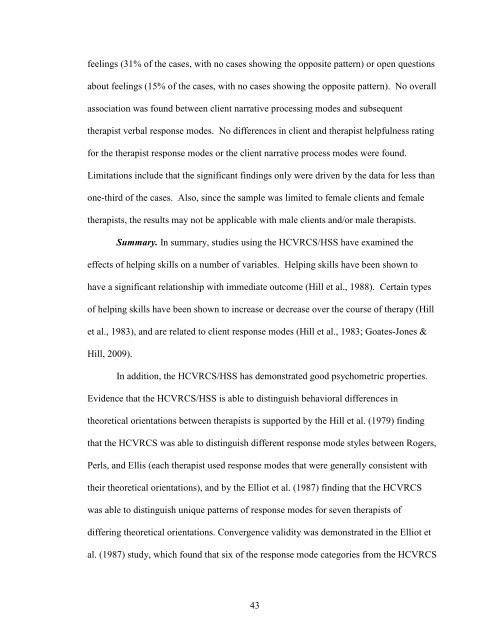PSYCHOTHERAPY ENGAGERS VERSUS NON-ENGAGERS
PSYCHOTHERAPY ENGAGERS VERSUS NON-ENGAGERS
PSYCHOTHERAPY ENGAGERS VERSUS NON-ENGAGERS
You also want an ePaper? Increase the reach of your titles
YUMPU automatically turns print PDFs into web optimized ePapers that Google loves.
feelings (31% of the cases, with no cases showing the opposite pattern) or open questions<br />
about feelings (15% of the cases, with no cases showing the opposite pattern). No overall<br />
association was found between client narrative processing modes and subsequent<br />
therapist verbal response modes. No differences in client and therapist helpfulness rating<br />
for the therapist response modes or the client narrative process modes were found.<br />
Limitations include that the significant findings only were driven by the data for less than<br />
one-third of the cases. Also, since the sample was limited to female clients and female<br />
therapists, the results may not be applicable with male clients and/or male therapists.<br />
Summary. In summary, studies using the HCVRCS/HSS have examined the<br />
effects of helping skills on a number of variables. Helping skills have been shown to<br />
have a significant relationship with immediate outcome (Hill et al., 1988). Certain types<br />
of helping skills have been shown to increase or decrease over the course of therapy (Hill<br />
et al., 1983), and are related to client response modes (Hill et al., 1983; Goates-Jones &<br />
Hill, 2009).<br />
In addition, the HCVRCS/HSS has demonstrated good psychometric properties.<br />
Evidence that the HCVRCS/HSS is able to distinguish behavioral differences in<br />
theoretical orientations between therapists is supported by the Hill et al. (1979) finding<br />
that the HCVRCS was able to distinguish different response mode styles between Rogers,<br />
Perls, and Ellis (each therapist used response modes that were generally consistent with<br />
their theoretical orientations), and by the Elliot et al. (1987) finding that the HCVRCS<br />
was able to distinguish unique patterns of response modes for seven therapists of<br />
differing theoretical orientations. Convergence validity was demonstrated in the Elliot et<br />
al. (1987) study, which found that six of the response mode categories from the HCVRCS<br />
43

















